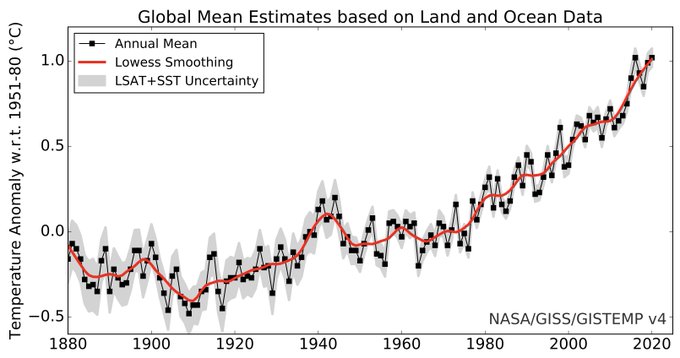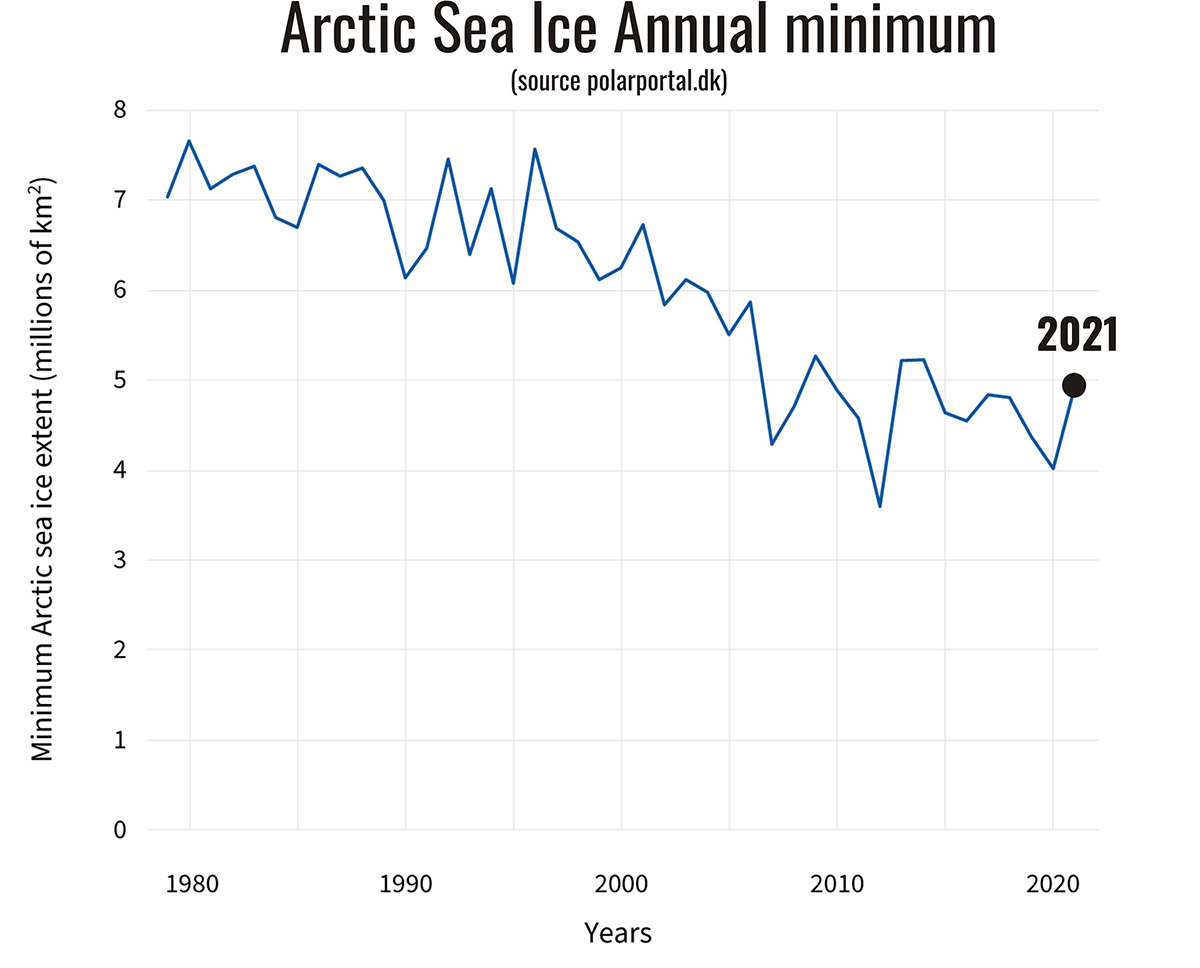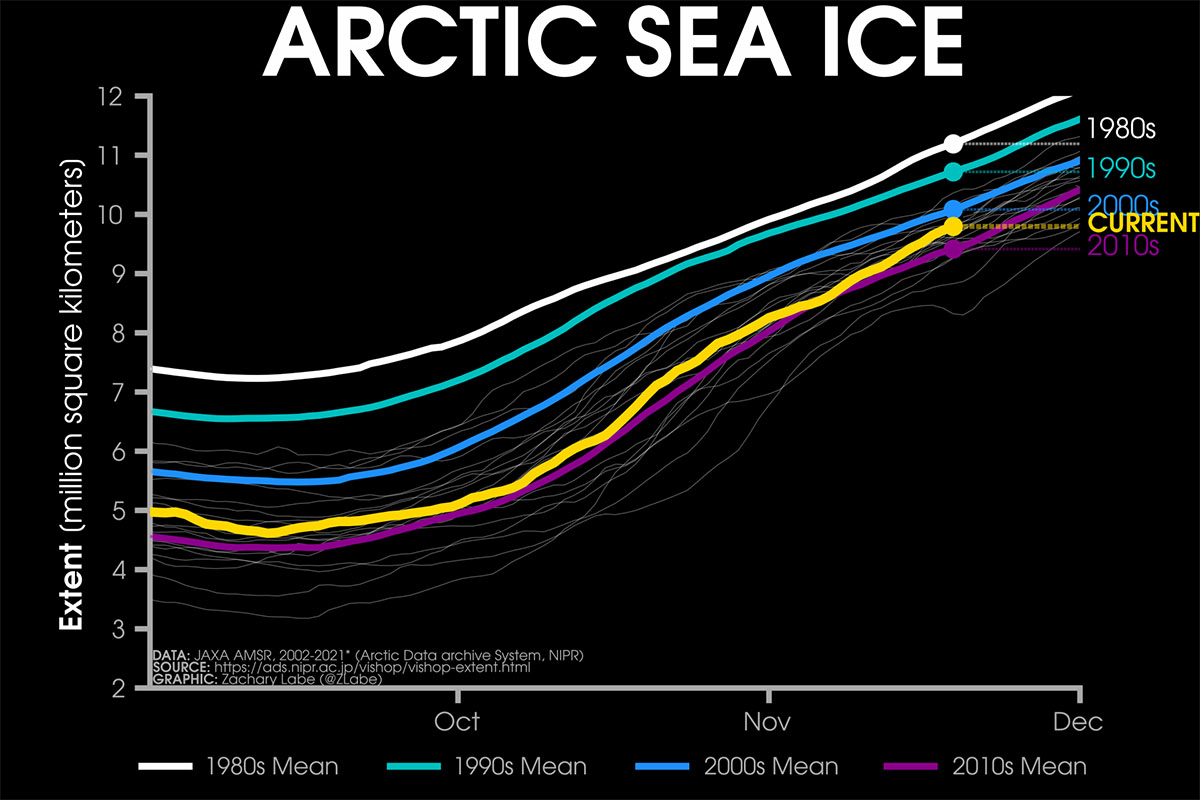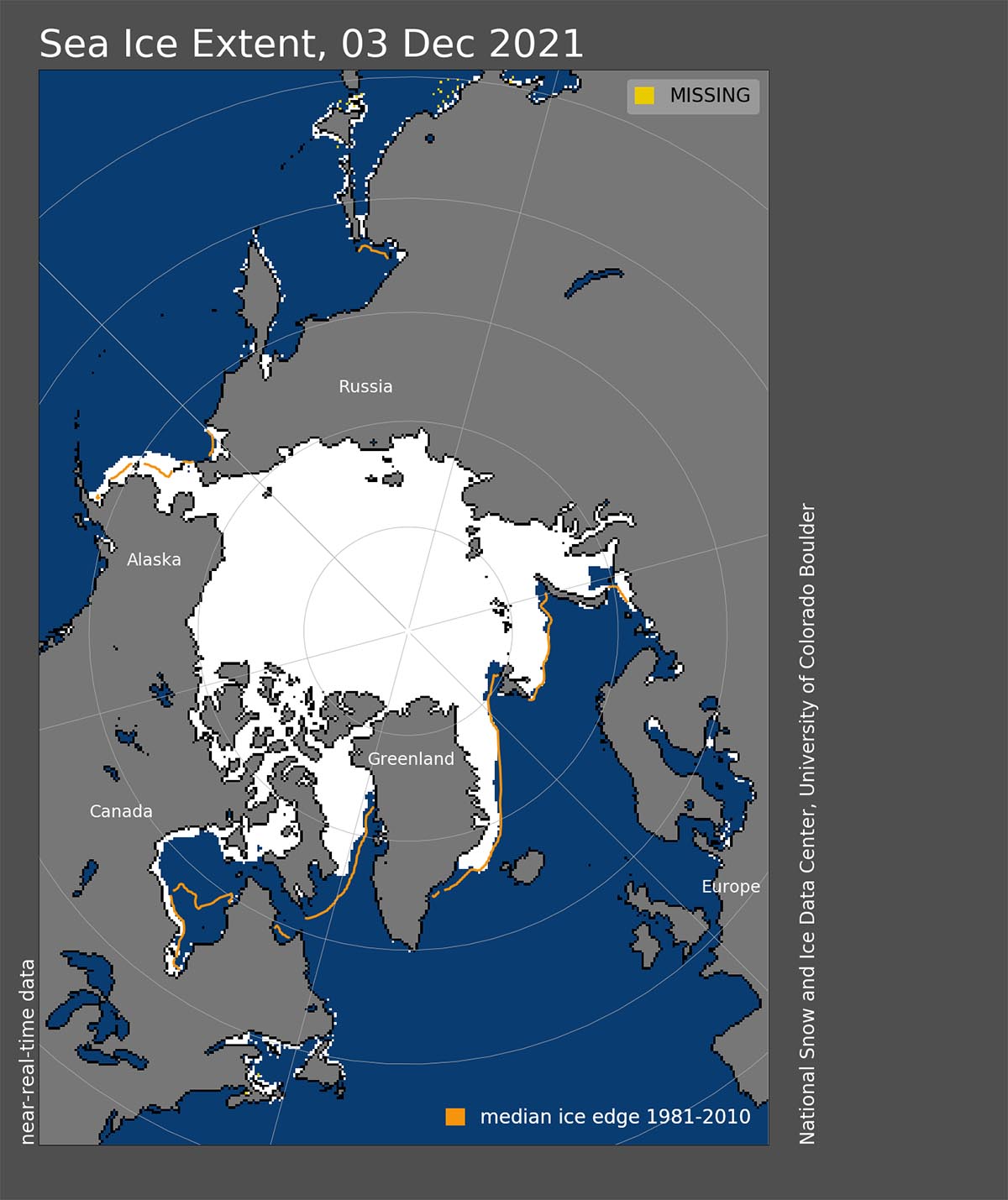Nearly all actively publishing climate scientists (97–98%) support the consensus on anthropogenic climate change, and the remaining 2% of contrarian studies either cannot be replicated or contain errors. A 2019 study found scientific consensus to be at 100%, and a 2021 study concluded that consensus exceeded 99%.
Global Warming [Comment by mortals only, please]
Moderator: Community Team
Re: Global Warming [Comment by mortals only, please]
JP4Fun


-

 jusplay4fun
jusplay4fun
- Posts: 7122
- Joined: Sun Jun 16, 2013 8:21 pm
- Location: Virginia






















-

 fat bastard
fat bastard
- Posts: 17
- Joined: Wed Oct 21, 2015 9:47 pm
- Location: united states









Re: Global Warming [Comment by mortals only, please]
https://www.cnn.com/2021/10/09/weather/ ... index.html
more lies ?
looks like no action since i last posted.......
I am back so shoot me some graphs you narcissistic fools.
more lies ?
looks like no action since i last posted.......
I am back so shoot me some graphs you narcissistic fools.
Last edited by fat bastard on Tue Mar 08, 2022 10:22 pm, edited 1 time in total.
-

 fat bastard
fat bastard
- Posts: 17
- Joined: Wed Oct 21, 2015 9:47 pm
- Location: united states









Re: Global Warming [Comment by mortals only, please]
fat bastard wrote:https://www.cnn.com/2021/10/09/weather/weather-record-cold-antarctica-climate-change/index.html
more lies ?
There are no lies, just misleading suggestions.
It assumes that he ignored what is stated in the article he cites:
One extremely cold winter is intriguing from a record keeping standpoint, but one season alone does not change the long-term progression, which is rapid warming.
Literally everywhere else is warming
What is happening at Earth's poles, does not mean it is happening across the globe equally.
"Although global temperatures have risen by about 1.1 degrees in the past 150 years on average, different parts of the globe have warmed at different rates due to natural variations in the climate system such as cloud cover, land cover and atmospheric circulation patterns," Slater said.
"Earth's poles have warmed faster than anywhere else, primarily due to melting ice and snow. Although Antarctica has had a cold winter this year, over the past few decades the most northerly parts of Antarctica have warmed five times faster than the global average -- that's faster than anywhere else in the Southern Hemisphere."
and, again, from his own source:

What lies are your referencing? I see none, if you go beyond the headlines and actually READ what you posted.
JP4Fun


-

 jusplay4fun
jusplay4fun
- Posts: 7122
- Joined: Sun Jun 16, 2013 8:21 pm
- Location: Virginia






















-

 fat bastard
fat bastard
- Posts: 17
- Joined: Wed Oct 21, 2015 9:47 pm
- Location: united states









Re: Global Warming [Comment by mortals only, please]
fat bastard wrote:https://www.severe-weather.eu/cryosphere/arctic-sea-ice-froze-faster-november-ten-millions-square-kilometers-rrc/
poles warming ?
Do you even read these before posting as evidence against global warming or just peek at the headlines and draw your conclusion from that?
Ice caps shrinking over time (directly from your link...)




ConfederateSS wrote: Vote for Kamala
-

 mookiemcgee
mookiemcgee
- Posts: 5333
- Joined: Wed Jul 03, 2013 2:33 pm
- Location: Northern CA






























Re: Global Warming [Comment by mortals only, please]
Based on earlier posts by this fat bastard guy, I think your hypothesis is correct, Mookie. I have called him on the same conjecture.
Those are very good data and graphics, too, Mookie. (There is no point to re-post ALL that; they stand sufficiently lucid and cogent for those who reCOGnize facts and analysis.)
mookiemcgee on Tue Dec 07, 2021 5:41 pm
said:
Those are very good data and graphics, too, Mookie. (There is no point to re-post ALL that; they stand sufficiently lucid and cogent for those who reCOGnize facts and analysis.)
mookiemcgee on Tue Dec 07, 2021 5:41 pm
said:
poles warming ?
Do you even read these before posting as evidence against global warming or just peek at the headlines and draw your conclusion from that?
Ice caps shrinking over time (directly from your link...)
JP4Fun


-

 jusplay4fun
jusplay4fun
- Posts: 7122
- Joined: Sun Jun 16, 2013 8:21 pm
- Location: Virginia






















Re: Global Warming [Comment by mortals only, please]
The earth is on fire. Anybody who's still in denial
https://nypost.com/2021/12/03/fears-chi ... dest-town/
more lies
https://nypost.com/2021/12/03/fears-chi ... dest-town/
more lies
-

 fat bastard
fat bastard
- Posts: 17
- Joined: Wed Oct 21, 2015 9:47 pm
- Location: united states









Re: Global Warming [Comment by mortals only, please]
i don't think this fat f*ck understands how climate change works... 

-

 riskllama
riskllama
- Posts: 8907
- Joined: Thu Jan 30, 2014 9:50 pm
- Location: deep inside Queen Charlotte.






























Re: Global Warming [Comment by mortals only, please]
fat bastard can read and LEARN from the posts here and others on this topic in this Forum.
Read and Learn; imagine THAT...!
Read and Learn; imagine THAT...!
JP4Fun


-

 jusplay4fun
jusplay4fun
- Posts: 7122
- Joined: Sun Jun 16, 2013 8:21 pm
- Location: Virginia






















Re: Global Warming [Comment by mortals only, please]
riskllama wrote:i don't think this fat f*ck understands how climate change works...
there aren't usually giant forest fires in Dec in Canada? Now I'm totally confused about how the environment works.
ConfederateSS wrote: Vote for Kamala
-

 mookiemcgee
mookiemcgee
- Posts: 5333
- Joined: Wed Jul 03, 2013 2:33 pm
- Location: Northern CA






























Re: Global Warming [Comment by mortals only, please]
Sin heats the planet up and it burns.
-

 HitRed
HitRed
- Posts: 4874
- Joined: Fri Jun 26, 2015 12:16 pm




























Re: Global Warming [Comment by mortals only, please]
ITT I learned sin = fossil fuels
ConfederateSS wrote: Vote for Kamala
-

 mookiemcgee
mookiemcgee
- Posts: 5333
- Joined: Wed Jul 03, 2013 2:33 pm
- Location: Northern CA






























-

 fat bastard
fat bastard
- Posts: 17
- Joined: Wed Oct 21, 2015 9:47 pm
- Location: united states









Re: Global Warming [Comment by mortals only, please]
fat bastard wrote:https://thenewamerican.com/nasa-sees-climate-cooling-trend-thanks-to-low-sun-activity/
NOTE that no comment or even a synopsis of the article is given. I can see the reason why.
Obviously the article is written by an unbiased and distinguished climate scientist:
James Murphy
James Murphy is a freelance journalist who writes on a variety of subjects with a primary focus on the ongoing anthropogenic climate-change hoax and cultural issues
Keep searching the Haystack for those hidden needles and pearls of wisdom, fat bastard.
and from his own source, a link that shows how little fat bastard knows about this matter:
https://upload.wikimedia.org/wikipedia/commons/thumb/2/28/Sunspot_Numbers.png/330px-Sunspot_Numbers.png
JP4Fun


-

 jusplay4fun
jusplay4fun
- Posts: 7122
- Joined: Sun Jun 16, 2013 8:21 pm
- Location: Virginia






















-

 riskllama
riskllama
- Posts: 8907
- Joined: Thu Jan 30, 2014 9:50 pm
- Location: deep inside Queen Charlotte.






























Re: Global Warming [Comment by mortals only, please]
bigtoughralf wrote:I love how energized he is about trying to prove something that's already been proven. Next he's gonna start a thread debunking the flat earth theory.
by bigtoughralf on Wed Sep 22, 2021 6:05 pm
With fat bastard sharing his "great sources" and spreading false allegations, it is time to revisit the "wisdom" of ralf.
btw: the quote from ralf is on page ONE of this thread:
And, ralf, just to clarify, vegetarians do not eat meat, they eat vegetables. And the earth is not flat.
Eratosthenes’ most famous accomplishment is his measurement of the circumference of Earth. He recorded the details of this measurement in a manuscript that is now lost, but his technique has been described by other Greek historians and writers.
Eratosthenes was fascinated with geography and planned to make a map of the entire world. He realized he needed to know the size of Earth. Obviously, one couldn’t walk all the way around to figure it out.
Eratosthenes had heard from travelers about a well in Syene (now Aswan, Egypt) with an interesting property: at noon on the summer solstice, which occurs about June 21 every year, the sun illuminated the entire bottom of this well, without casting any shadows, indicating that the sun was directly overhead. Eratosthenes then measured the angle of a shadow cast by a stick at noon on the summer solstice in Alexandria, and found it made an angle of about 7.2 degrees, or about 1/50 of a complete circle.
He realized that if he knew the distance from Alexandria to Syene, he could easily calculate the circumference of Earth. But in those days it was extremely difficult to determine distance with any accuracy. Some distances between cities were measured by the time it took a camel caravan to travel from one city to the other. But camels have a tendency to wander and to walk at varying speeds. So Eratosthenes hired bematists, professional surveyors trained to walk with equal length steps. They found that Syene lies about 5000 stadia from Alexandria.
Eratosthenes then used this to calculate the circumference of the Earth to be about 250,000 stadia. Modern scholars disagree about the length of the stadium used by Eratosthenes. Values between 500 and about 600 feet have been suggested, putting Eratosthenes’ calculated circumference between about 24,000 miles and about 29,000 miles. The Earth is now known to measure about 24,900 miles around the equator, slightly less around the poles.
Eratosthenes had made the assumption that the sun was so far away that its rays were essentially parallel, that Alexandria is due north of Syene, and that Syene is exactly on the tropic of cancer. While not exactly correct, these assumptions are good enough to make a quite accurate measurement using Eratosthenes’ method. His basic method is sound, and is even used by schoolchildren around the world today.
Other Greek scholars repeated the feat of measuring the Earth using a procedure similar to Eratosthenes’ method. Several decades after Eratosthenes measurement, Posidonius used the star Canopus as his light source and the cities of Rhodes and Alexandria as his baseline. But because he had an incorrect value for the distance between Rhodes and Alexandria, he came up with a value for Earth’s circumference of about 18,000 miles, nearly 7,000 miles too small.
Ptolemy included this smaller value in his treatise on geography in the second century A.D. Later explorers, including Christopher Columbus, believed Ptolemy’s value and became convinced that Earth was small enough to sail around. If Columbus had instead known Eratosthenes larger, and more accurate, value, perhaps he might never have set sail.
https://www.aps.org/publications/apsnews/200606/history.cfm
This Month in Physics History
June, ca. 240 B.C. Eratosthenes Measures the Earth
ralf, I know a bit of Physics. Do you?
JP4Fun


-

 jusplay4fun
jusplay4fun
- Posts: 7122
- Joined: Sun Jun 16, 2013 8:21 pm
- Location: Virginia






















Re: Global Warming [Comment by mortals only, please]
Based on the big number post by the SAME posters i guess can stop posting for a few years........and come back!
Brilliant posters are a dime a dozen. It is so easy to copy and paste bullshit.
Enjoy your little pictures and charts while the earth is on fire.
Brilliant posters are a dime a dozen. It is so easy to copy and paste bullshit.
Enjoy your little pictures and charts while the earth is on fire.
-

 fat bastard
fat bastard
- Posts: 17
- Joined: Wed Oct 21, 2015 9:47 pm
- Location: united states









Re: Global Warming [Comment by mortals only, please]
the fat bastard is what his name implies, full of gas and bullshit.
https://en.wikipedia.org/wiki/Fat_Bastard
And he can't handle the truth.
Fat Bastard is a fictional character in the second and third films of the Austin Powers series. A morbidly obese henchman hailing from Scotland, Fat Bastard serves Dr. Evil in his quest to destroy Austin Powers. The character is portrayed by Mike Myers.[1][2][3]
Fat Bastard is noted for his foul temper, his emotional monologues that culminate in flatulence, his vulgar, crude manners, and his unusual diet.
https://en.wikipedia.org/wiki/Fat_Bastard
And he can't handle the truth.
JP4Fun


-

 jusplay4fun
jusplay4fun
- Posts: 7122
- Joined: Sun Jun 16, 2013 8:21 pm
- Location: Virginia






















Re: Global Warming [Comment by mortals only, please]
The Thwaites Glacier may break free within 10 years, possibly even within 5.
https://news.climate.columbia.edu/2021/12/17/crucial-antarctic-glacier-likely-to-collapse-much-earlier-than-expected/

https://news.climate.columbia.edu/2021/12/17/crucial-antarctic-glacier-likely-to-collapse-much-earlier-than-expected/

“Life is a shipwreck, but we must not forget to sing in the lifeboats.”
― Voltaire
― Voltaire
-

 Dukasaur
Dukasaur
- Community Coordinator

- Posts: 27718
- Joined: Sat Nov 20, 2010 4:49 pm
- Location: Beautiful Niagara





























 3
3




 2
2


Re: Global Warming [Comment by mortals only, please]
To help put this in context:
skip to:
https://en.wikipedia.org/wiki/Thwaites_Glacier
Thwaites Glacier
From Wikipedia, the free encyclopedia
Thwaites Glacier, sometimes referred to as the Doomsday Glacier,[1] is an unusually broad and vast Antarctic glacier flowing into Pine Island Bay, part of the Amundsen Sea, east of Mount Murphy, on the Walgreen Coast of Marie Byrd Land.[2] Its surface speeds exceed 2 kilometres (1.2 miles) per year near its grounding line. Its fastest flowing grounded ice is centered between 50 and 100 kilometres (31 and 62 mi) east of Mount Murphy. In 1967, the Advisory Committee on Antarctic Names named the glacier after Fredrik T. Thwaites (1883–1961), a glacial geologist, geomorphologist and professor emeritus at the University of Wisconsin–Madison.[3][4] The historian Reuben Gold Thwaites was his father.[5]
Thwaites Glacier is closely watched for its potential to raise sea levels.[6] Along with the Pine Island Glacier, it has been described as part of the "weak underbelly" of the West Antarctic Ice Sheet, due to its apparent vulnerability to significant retreat. This hypothesis is based on both theoretical studies of the stability of marine ice sheets and observations of large changes on these two glaciers. In recent years, the flow of both of these glaciers has accelerated, their surfaces have lowered, and their grounding lines have retreated.
The Thwaites Ice Shelf, a floating ice shelf which braces and restrains the eastern portion of Thwaites Glacier, is likely to collapse within a decade from 2021, leading to increased outflow and contribution to sea-level rise.[7][8][9]
skip to:
In 2020, scientists discovered warm water underneath the glacier for the first time.[14][15] The place where the glacier was in contact with the sea had been recorded as 2 degree Celsius above the freezing temperature.[16] The discovery was a part of the International Thwaites Glacier Collaboration, a partnership primarily between US and UK academic institutions. This study has raised alarm regarding the glacier collapse, which can lead to nearly 3 ft (0.9 m) rise in the sea level.[17]
Extensive calving at the marine terminus of Thwaites Glacier is monitored by remote sensing and seismological observations, with the largest events being seismically detectable at ranges up to 1600 km.[18]
https://en.wikipedia.org/wiki/Thwaites_Glacier
JP4Fun


-

 jusplay4fun
jusplay4fun
- Posts: 7122
- Joined: Sun Jun 16, 2013 8:21 pm
- Location: Virginia






















Re: Global Warming [Comment by mortals only, please]
Did you get your energy credits yet?
You plan to save the planet by destroying countries
Hope you climate Nazis have deep pockets!
You plan to save the planet by destroying countries
Hope you climate Nazis have deep pockets!
-

 fat bastard
fat bastard
- Posts: 17
- Joined: Wed Oct 21, 2015 9:47 pm
- Location: united states









Re: Global Warming [Comment by mortals only, please]
I want to tell two (anecdotal) stories about Global Warming:
1) My teenage neighbor's son used to rake leaves and make what appeared to be fake and freshly dug graves before Halloween. He then decorated them with a cross or tombstone. Now the leaves where I live do not fall until mid-November. The leaves do not fall early enough to make even ONE fake grave. He did so about 25 years ago.
2) I used to enjoy the blooming daffodils in March, usually about NOW. This year, they bloomed about one week before February ended.
The point: there is warmer and shorter winters with later leaves falling and earlier blooms. THUS Global Warming.
And the pictures comparing glaciers with then and now pictures from 40 years ago? That is NOT anecdotal evidence. And neither is the rising world CO2 levels at Mauna Loa Observatory, cited already in this Forum.
QED
The fat bastard only offers his myopic and clearly uninformed opinion, or opinions formed by listening to non-scientists on right-wing websites. If he is a typical such right-wing nut, he drives an old truck that gets 10 mpg and lashes out at those he blames for higher gasoline prices. Instead, go thank your buddy pukin' putin, you fat bastard.
1) My teenage neighbor's son used to rake leaves and make what appeared to be fake and freshly dug graves before Halloween. He then decorated them with a cross or tombstone. Now the leaves where I live do not fall until mid-November. The leaves do not fall early enough to make even ONE fake grave. He did so about 25 years ago.
2) I used to enjoy the blooming daffodils in March, usually about NOW. This year, they bloomed about one week before February ended.
The point: there is warmer and shorter winters with later leaves falling and earlier blooms. THUS Global Warming.
And the pictures comparing glaciers with then and now pictures from 40 years ago? That is NOT anecdotal evidence. And neither is the rising world CO2 levels at Mauna Loa Observatory, cited already in this Forum.
QED
The fat bastard only offers his myopic and clearly uninformed opinion, or opinions formed by listening to non-scientists on right-wing websites. If he is a typical such right-wing nut, he drives an old truck that gets 10 mpg and lashes out at those he blames for higher gasoline prices. Instead, go thank your buddy pukin' putin, you fat bastard.
Last edited by jusplay4fun on Mon Apr 18, 2022 3:21 pm, edited 1 time in total.
JP4Fun


-

 jusplay4fun
jusplay4fun
- Posts: 7122
- Joined: Sun Jun 16, 2013 8:21 pm
- Location: Virginia






















Re: Global Warming [Comment by mortals only, please]
------Blah,blah... Global Warming...Snowing in Motown...Blah,blah....More like a mimi..Ice Age warning...All though , I love the snow...Plus, it is a slap in the face of all the global worriers...The Earth is melting, melting...They might as well be the wicked witch of the west... 

 ...
...  ConfederateSS.out!(The Blue and Silver Rebellion)...
ConfederateSS.out!(The Blue and Silver Rebellion)... 
-

 ConfederateSS
ConfederateSS
- Posts: 3608
- Joined: Wed Dec 31, 2008 1:50 pm
- Location: THE CONFEDERATE STATES of AMERICA and THE OLD WEST!
























 7
7 3
3



Return to Out, out, brief candle!
Who is online
Users browsing this forum: No registered users

